If the Rear Cross Traffic Auto Brake function detects that a collision
with an approaching vehicle is possible, the engine output will be
restricted to restrain any increase in vehicle speed. (Engine output
restriction control: See A below.)
Additionally, if the accelerator pedal continues to be depressed, the
brakes will be applied automatically to reduce the vehicle speed.
(Brake control: See B below.)

- Accelerator pedal
- Brake pedal
- Engine output
- Braking force
- Start of control
- High possibility of a collision
- Extremely high possibility of a
collision
■The Rear Cross Traffic Auto Brake function will operate when
The function will operate when the ICS OFF indicator is not illuminated or
flashing and all of the following conditions are met:
- Engine output restriction control
- The Intelligent Clearance Sonar with Rear Cross Traffic Auto Brake
is
enabled.
- The vehicle speed is 10 mph (15 km/h) or less.
- Vehicles which are approaching from the right or left at the rear of
the
vehicle at a traveling speed of less than approximately 5 mph (8 km/h)
- The shift lever is in R.
- The system determines that a stronger than normal brake operation is
necessary to avoid a collision with an approaching vehicle.
- Brake control
- Engine output restriction control is operating.
- The system determines that an emergency brake operation is necessary
to avoid a collision with an approaching vehicle.
■The Rear Cross Traffic Auto Brake function will stop operating when
The function will stop operating if any of the following conditions are met:
- Engine output restriction control
- The Intelligent Clearance Sonar with Rear Cross Traffic Auto Brake
is
disabled.
- The collision becomes avoidable with normal brake operation.
- A vehicle is no longer approaching from the right or left at the
rear of the
vehicle.
- Brake control
- The Intelligent Clearance Sonar with Rear Cross Traffic Auto Brake
is
disabled.
- Approximately 2 seconds elapse after the vehicle is stopped by brake
control.
- The brake pedal is depressed after the vehicle is stopped by brake
control.
- A vehicle is no longer approaching from the right or left at the
rear of the
vehicle.
■Detection area of the Rear Cross Traffic Auto Brake function
The detection area of the Rear Cross Traffic Auto Brake function differs
from
the detection area of the RCTA function.
Therefore, even if the RCTA function detects a vehicle and provides an alert,
the Rear Cross Traffic Auto Brake function may not start operating.
■If the Rear Cross Traffic Auto Brake function has operated
If the vehicle is stopped due to operation of the Rear Cross Traffic Auto
Brake
function, the Rear Cross Traffic Auto Brake function will be disabled and the
ICS OFF indicator will illuminate.
■Re-enabling the Rear Cross Traffic Auto Brake function
To re-enable the Rear Cross Traffic Auto Brake function when it is disabled
while it is operating, either enable the Intelligent Clearance Sonar system
again, or turn the engine switch off and then back to IGNITION ON
mode. When the function is disabled, the ICS OFF indicator will illuminate.
If there is no longer a vehicle approaching from the right or left at the rear
of
the vehicle when backing up, or if the traveling direction of the vehicle
changes (such as changing from backing up to moving forward), the system
will be re-enabled automatically. When the function is re-enabled, the ICS
OFF indicator will turn off.
■Conditions under which the Rear Cross Traffic Auto Brake function will
not detect a vehicle
The Rear Cross Traffic Auto Brake function is not designed to detect the
following
types of vehicles and/or objects.
- Vehicles approaching from directly behind
- Vehicles backing up in a parking space next to your vehicle
- Vehicles that the sensors cannot detect
due to obstructions
- Vehicles which suddenly accelerate or
decelerate near your vehicle
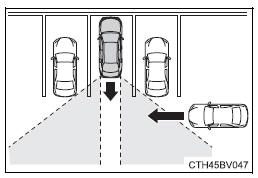
- Guardrails, walls, signs, parked vehicles and similar stationary
objects*
- Small motorcycles, bicycles, pedestrians, etc.*
- Vehicles moving away from your vehicle
- Vehicles approaching from the parking spaces next to your vehicle*
*: Depending on the conditions, detection of a vehicle and/or object may
occur.
■RCTA function buzzer
Regardless of whether the RCTA function is enabled or not, if the
Rear Cross Traffic Auto Brake function is enabled and brake control is
performed,
a buzzer will sound to notify the driver.
■Situations in which the system may operate even though there is no
possibility of a collision
In some situations such as the following, the Rear Cross Traffic Auto Brake
function may operate even though there is no possibility of a collision.
- When the parking space faces a street
and vehicles are being driven on the
street
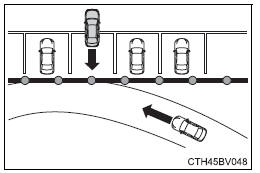
- When a detected vehicle turns while
approaching the vehicle
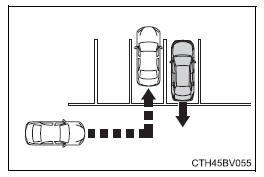
- When a detected vehicle turns while
approaching the vehicle

- When the distance between your vehicle
and metal objects, such as a guardrail,
wall, sign, or parked vehicle, which may
reflect electrical waves toward the rear
of the vehicle, is short

- When there are spinning objects near your vehicle such as the fan of an
air
conditioning unit
- When water is splashed or sprayed toward the rear bumper, such as from a
sprinkler
■Situations in which the Rear Cross Traffic Auto Brake function may not
operate properly
In some situations such as the following, this function may not operate
properly.
- Objects and vehicles which the radar sensors are not designed to detect
- Stationary objects
- Vehicles which are moving away from your vehicle
- Pedestrians, motorcycles, bicycles, etc.*
- Objects which are extremely close to a radar sensor
- Vehicles which are approaching from the right or left at the rear of
the
vehicle at a traveling speed of less than approximately 5 mph (8 km/h)
- Vehicles which are approaching from the right or left at the rear of
the
vehicle at a traveling speed of more than approximately 15 mph (24 km/h)
*: Depending on conditions, detection of a vehicle and/or object may occur.
- Situations in which the radar sensors may not be able to detect an
object
- When a sensor or the area around a sensor is extremely hot or cold
- If the rear bumper is covered with ice, snow, dirt, etc.
- If heavy rain or water strikes the vehicle
- When the detection area of a radar sensor is obstructed by an
adjacent
vehicle
- If the vehicle is significantly tilted
- When equipment that may obstruct a sensor is installed, such as a
towing
eyelet, bumper protector (an additional trim strip, etc.), bicycle
carrier, or
snow plow
- If the suspension has been modified or tires of a size other than
specified
are installed
- If the front of the vehicle is raised or lowered due to the carried
load
- If a sticker or an electronic component, such as a backlit license
plate
(especially fluorescent type), fog lights, a fender pole or wireless
antenna
is installed near a radar sensor
- If the orientation of a radar sensor has been changed due to a
collision or
other impact or removal and installation
- When multiple vehicles are approaching with only a small gap between
each vehicle
- When a vehicle is approaching at high speed
- Situations in which the radar sensor may not detect a vehicle
- When a vehicle approaches from the
right or left at the rear of the vehicle
while you are turning while backing
up
- When turning while backing up
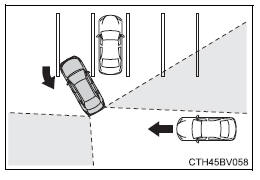
- When backing out of a shallow angle
parking spot

- Vehicles that the sensors cannot
detect due to obstructions

- When backing up on a slope with a
sharp change in grade
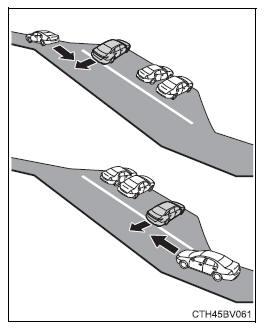
- When a vehicle turns into the detection
area

|